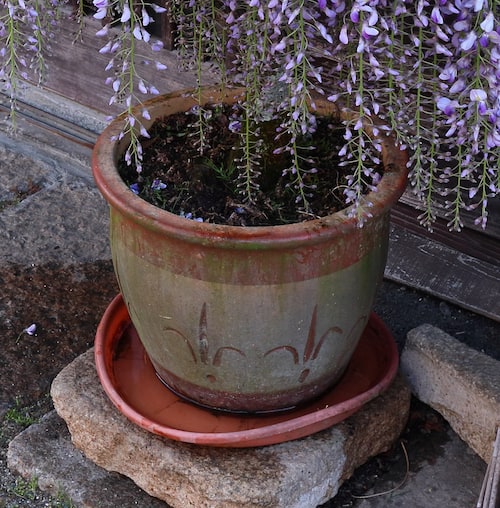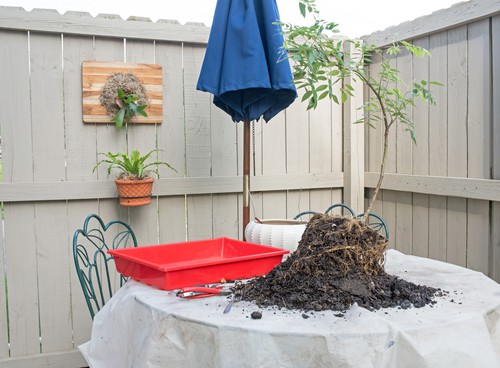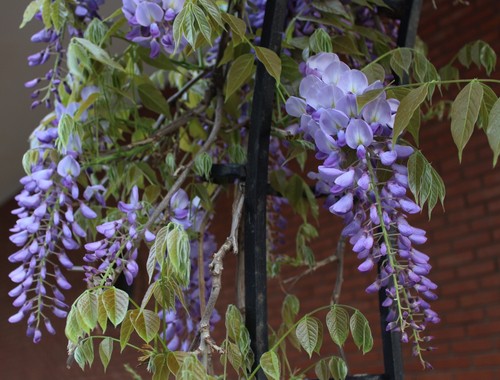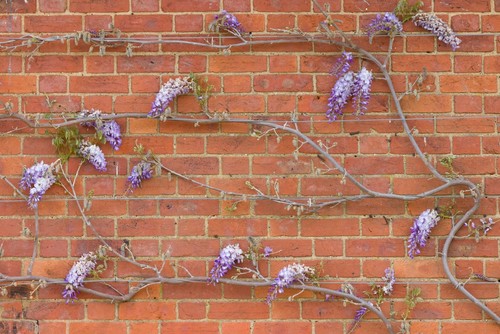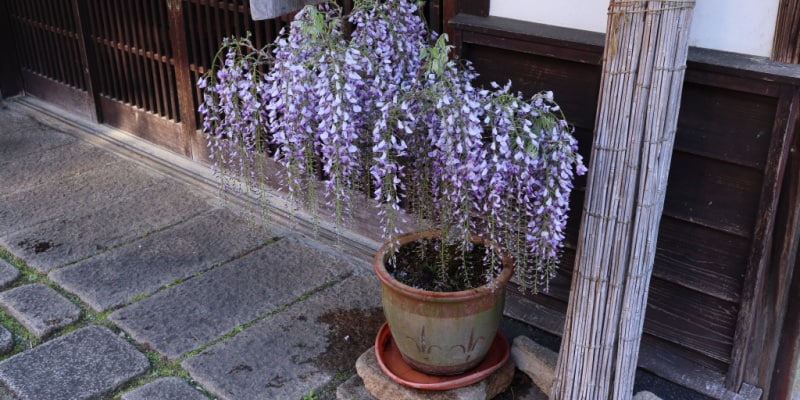
Growing Wisteria climbers in pots and containers
Our site is reader supported, this means we may earn a small commission from Amazon and other affiliates when you buy through links on our site.
Growing Wisteria in pots and containers is a bit tricky if you choose one of the more vigorous growing varieties of Wisteria. This is one of the main reasons that I prefer to plant compact varieties such as Wisteria ‘Amethyst Falls’ as these will grow better in pots because they are naturally less vigorous.
That being said, you can still successfully grow other large varieties such as Wisteria sinensis and Wisteria floribunda in pots. Wisterias grown in pots are great when they are grown as a standard (small tree), but you can still grow them up a wall too if that is your preference. I have seen some very large Wisterias grown in pots, however, they do require more care than those being grown in the ground, especially when it comes to feeding and watering. The advantage of growing them in a pot is that it is easier to maintain their size, avoid damage to the structure of your house and it is a great alternative for those who have got the space to grow them in the ground.
Choosing the right pot for the job
Wisterias grow fast and hard so you need a pot large enough to contain them but not so large that the plants are able to grow out of control. Choose a pot that is a little larger than the one it is already in. Feel free to choose a larger one if your Wisteria plant is quite large, to begin with.
Plastic pots
The pot you choose can be made out of any material. Plastic is lightweight and easy to care for, however, if you plan to grow a tall Wisteria, you will need to weigh down the pot with stones in the bottom as the plant becomes top heavy and may topple over. This is especially true if you grow a Wisteria as a standard (like a small tree). You may find that over time your plastic pots become brittle and need replacing, they are also more likely to crack if they blow over.
Ceramic, terracotta and concrete pots
Ceramic, terracotta and even concrete pots are heavier than plastic and make good pots for Wisteria. In fact, I always opt to use these kinds of pots because they will likely last longer and are naturally heavy.
Whichever material you choose, ensure that there are plenty of drainage holes in the bottom of the pot and cover the holes with broken crockery (or stone) to stop them from getting blocked. This step is important because poor draining wet soil can lead to root rot and other root related issues, and this will eventually lead to wilting foliage and yellowing leaves. Wisterias like to be planted in moist and well-drained fertile soil. Of course, it’s easier to make extra holes in a plastic pot than in one made of ceramic or terracotta.
Choosing the right compost
Fill the pot with loam-based potting compost. You can either use a John Innes potting compost or compost for trees and shrubs. Wisterias are hungry plants and need access to nutrients that these compost provide.
Planting a Wisteria in a pot
Place the root ball of your Wisteria into the pot so that it’s planted at the same depth that it was in the original pot. Be careful not to bury the graft, as this can lead to graft failure. Backfill the hole with more compost and firm it down, making sure it isn’t too compact.
You can plant Wisterias in pots at any time of the year, although they are best planted in spring. Water the new plant in well.
Watering and feeding
Following on from choosing the right compost, it’s important to make sure your Wisteria gets enough water. Remember that Wisterias grown in pots need watering regularly, much more than those grown in the ground. I like to let the surface of the soil dry between watering.
Because Wisterias are hungry plants, they will quickly use up all the nutrients in the compost when grown in containers. Feed with a high potash feed monthly throughout summer, this will encourage better flowering and keep your Wisteria healthy.
Providing a support support
Provide a structure for the plant to wind its way up. Three bamboo poles placed vertically and equally around the plant give adequate structure for small plants when first planted. You can also grow them as a small tree up a single stake. If you choose a grow a Wisteria up a wall then you will need a sturdy structure such as a trellis or some wires because the stems can get very thick. One important thing to remember is that repotting a Wisteria that is growing up a wall can be quite difficult.
Caring for a potted Wisteria
Pruning
It’s down to you to keep your Wisteria maintained so that it doesn’t get out of control. They need to be pruned twice a year, usually around August and then again in February. You need to prune it in the summer to encourage the short flowering spurs that will develop into next year’s flowers. You need to cut back the current year’s growth back to a couple of buds.
You need to prune it again in the winter (February is a good time but anytime between October and March is fine) and you can cut back growth to the main framework and then cut the rest of the growth back hard.
My guide How to prune Wisteria explains how and when to do this in more detail.
Bear in mind that Wisteria growing in pots needs to be pruned more aggressively than those that are planted in the ground. You need to keep them pruned to a suitable height (usually 60cm to 120cm) unless you have them in very large pots and to a manageable width. When the plant has reached your desired height, prune away one-third of its new growth in the winter pruning session. This encourages stronger shoots and more flowers rather than straggly twiggy stems.
My guide on Growing Wisteria Amethyst Falls explains all the regular maintenance necessary for this Wisteria. As there are particular issues with growing Wisteria in pots and containers.
Pests and diseases
Watch out for the Wisteria scale. There are many other scale insects that will attack a Wisteria, however, the Wisteria scale is larger in size (at around 10mm) and usually black in colour. Also, check the graft itself is in good condition before planting to help prevent graft failure. You can learn more about Wisteria problems to look out for here where we have included more information on graft dieback.
Another common issue is the leaves of a Wisteria yellowing and wilting, you can learn more about it here.
